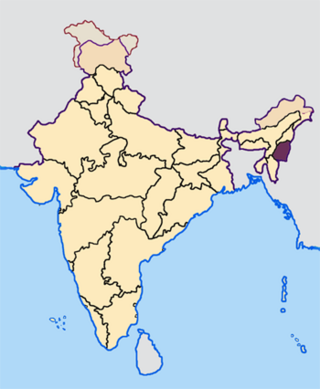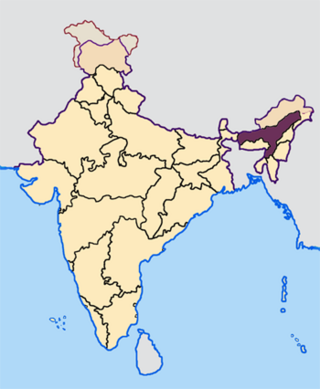
The United Liberation Front of Assam (ULFA) is an armed militant organisation operating in the Northeast Indian state of Assam. It seeks to establish an independent sovereign nation state of Assam for the indigenous Assamese people through an armed struggle in the Assam conflict. The Government of India banned the organisation in 1990 citing it as a terrorist organisation, while the United States Department of State lists it under "other groups of concern".

The National Democratic Front of Boroland (NDFB) was an armed separatist outfit which sought to obtain a sovereign Boroland for the Bodo people. It is designated as a terrorist organisation by the Government of India.

Terrorism in India, according to the Home Ministry, poses a significant threat to the people of India. Compared to other countries, India faces a wide range of terror groups. Terrorism found in India includes Islamic terrorism, ultranationalist terrorism, and left-wing terrorism India is one of the countries most impacted by terrorism.

Tarun Gogoi was an Indian politician and lawyer who served as the 13th Chief Minister of Assam from 2001 to 2016. He was the longest serving Chief Minister of Assam. He was a member of the Indian National Congress. During his tenure as the chief minister, he is credited with ending militant insurgency and mitigating violence in addition to improving the state's fiscal condition.
The Jaipur bombings were a series of nine synchronized bomb blasts that took place on 13 May 2008 within a span of fifteen minutes at locations in Jaipur, the capital city of the Indian state of Rajasthan and a tourist destination. Official reports confirm 63 dead with 216 or more people injured. The bombings shocked most of India and resulted in widespread condemnation from leaders across the world with many countries showing solidarity with India in its fight against terrorism.
2008 Bangalore serial blasts occurred on 25 July 2008 in Bangalore, India. A series of nine bombs exploded in which 1 person was killed and 20 injured. According to the Bangalore City Police, the blasts were caused by low-intensity crude bombs triggered by timers.

In the 2008 Imphal bombings, at least 17 people were killed and more than 30 were injured on 21 October 2008.

The 2009 Guwahati bombings occurred on 1 January 2009 in Guwahati, Assam, India. They occurred a few hours before Indian Home Minister P. Chidambaram was due to travel to the city.

The 2009 Assam serial blasts occurred on 6 April 2009 in the Maligaon and Dhekiajuli areas of the Assamese capital Guwahati on the eve of the Assamese Rajya Sabha MP and Indian Prime Minister Manmohan Singh's visit to address poll rallies. It also came during the campaigning phase of the 2009 Indian general election.

The 2004 Dhemaji school bombing occurred on 15 August 2004, on the occasion of Independence Day in Dhemaji, Assam. The bombing by the Assamese militant group called the United Liberation Front of Assam (ULFA) killed 18 people and injured many others. Most of the victims were schoolchildren aged between 12 and 14 and their mothers.

Assam separatist movements refers to a series of multiple insurgent and separatist movements that had been operated the in Northeast Indian state of Assam. The conflict started in the 1970s following tension between the native indigenous Assamese people and the Indian government over alleged neglect, political, social, cultural, economic issues and increased levels of illegal immigration from Bangladesh. The conflict has resulted in the deaths of 12,000 United Liberation Front of Assam (ULFA) militants and 18,000 others.

The 2011 Mumbai bombings, also known as 13/7, were a series of three coordinated bomb explosions at different locations in Mumbai, India, on 13 July 2011 between 18:54 and 19:06 IST. The blasts occurred at the Opera House, at Zaveri Bazaar and at Dadar West localities, leaving 26 killed and 130 injured. Indian Mujahideen is believed to have carried out the attack with the personal involvement of its co-founder Yasin Bhatkal.

In July 2012, violence in the Indian state of Assam broke out with riots between indigenous Bodos and Bengali Muslims in the Bodoland region of North East, India. The first incident was reported to have taken place on 20 July 2012. At least 108 people died and over 400,000 people were displaced into 270 relief camps, after being displaced from almost 400 villages. Eleven people have been reported missing.

On 7 July 2013 a series of ten bombs exploded in and around the Mahabodhi Temple complex, a UNESCO World Heritage Site in Bodh Gaya, India. Five people, including two Buddhist monks, were injured by the blasts. Three other devices were defused by bomb-disposal squads at a number of locations in Gaya.

From the night of 1 May 2014 until the early morning hours of 3 May a series of attacks occurred on the Bengali Muslims in Assam, a north-eastern state of India. The perpetrator is suspected to be the terrorist group National Democratic Front of Bodoland's Songbijit faction. Speculated to be revenge for not voting for the National Democratic Front in the Lok Sabha elections, the death toll reached 32.
In December 2014, a series of attacks by militants resulted in the deaths of more than 76 people in India. The attacks took place in the Chirang, Sonitpur, and Kokrajhar districts on 23 December 2014. They were attributed to the Songbijit faction of the National Democratic Front of Bodoland.
Assam – 16th largest, 15th most populous and 26th most literate state of the 28 states of the democratic Republic of India. Assam is at 14th position in life expectancy and 8th in female-to-male sex ratio. Assam is the 21st most media exposed states in India. The Economy of Assam is largely agriculture based with 69% of the population engaged in it. Growth rate of Assam's income has not kept pace with that of India's during the Post-British Era; differences increased rapidly since the 1970s. While the Indian economy grew at 6 percent per annum over the period of 1981 to 2000, the same of Assam's grew only by 3.3 percent.
Ranjan Daimary alias D.R. Nabla is the founder president of the armed separatist outfit National Democratic Front of Boroland. Daimary initially founded a militant group named Bodo Security Force in October 1986. Later, in 1994, Bodo Security Forced was renamed as National Democratic Front of Boroland.
G Bidai is the Commander and Vice-president of the militant outfit National Democratic Front of Boroland (NDFB). He is on the National Investigation Agency's (NIA)'s most wanted list, a primary counter-terrorist task force of India, with a bounty of Rupess 0.5 Million.











